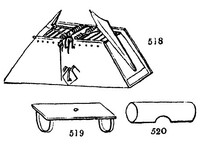1927. The mole-trap (figs. 519. and 520.) is of various forms, and is either made of wood or iron, or of both materials. There are several varieties to be obtained in the shops; none of which appear superior to the original bow-trap, which any labourer may form for him self. Moles may be effectually destroyed by taking their nests in spring. A French mole-trap is figured in the Gardener's Magazine, vol. viii. p. 36., and a newly invented mole-trap in the same volume, p. 298. This trap (figs. 521. and 522.) consists of a block of wood (a) ten inches long, three inches broad, and three inches and a half deep; with a hole (b) two inches and a half in diameter, bored lengthwise through both ends. In the inside, half an inch from each extremity, is a groove for a wire loop to fit into, as in the common mole traps, only that the grooves are here cut quite through, having a small nail or pin of wire driven in through the middle, to keep the wires from rising above the wood. In the upper side of the hole, close by the grooves, three blunt-pointed pikes of wire (c) are fixed, so as to stand a quarter of an inch out of the wood. The holes for the triggers are bored in the centre of the upper side, three inches from each end: in the lower side, opposite each trigger hole, is a small piece cut out, as in the common trap. The springs are made of iron wire, of about one eighth of an inch in diameter (d and e); and they are exactly of the same form as those of the common mouse-trap, having a cross wire fixed one inch and a half from the top of each spring (f and g); from which the catches, which are likewise made of wire (h), are suspended. These catches are retained by the plug or trigger (i), till it is displaced by the mole. Fig. 523. shows the trigger, of half the natural size.



